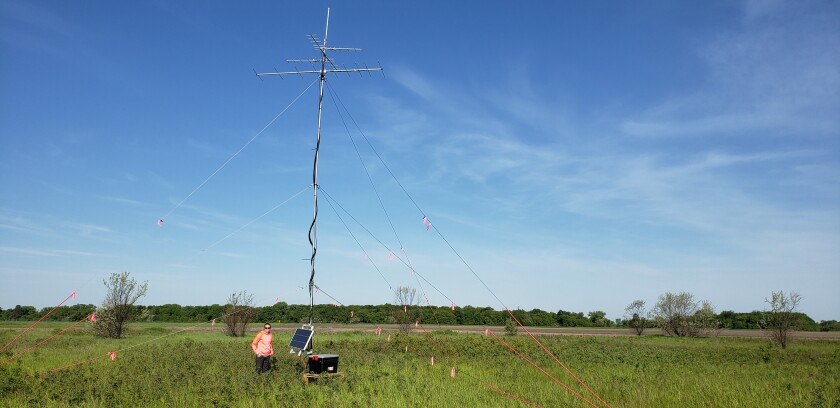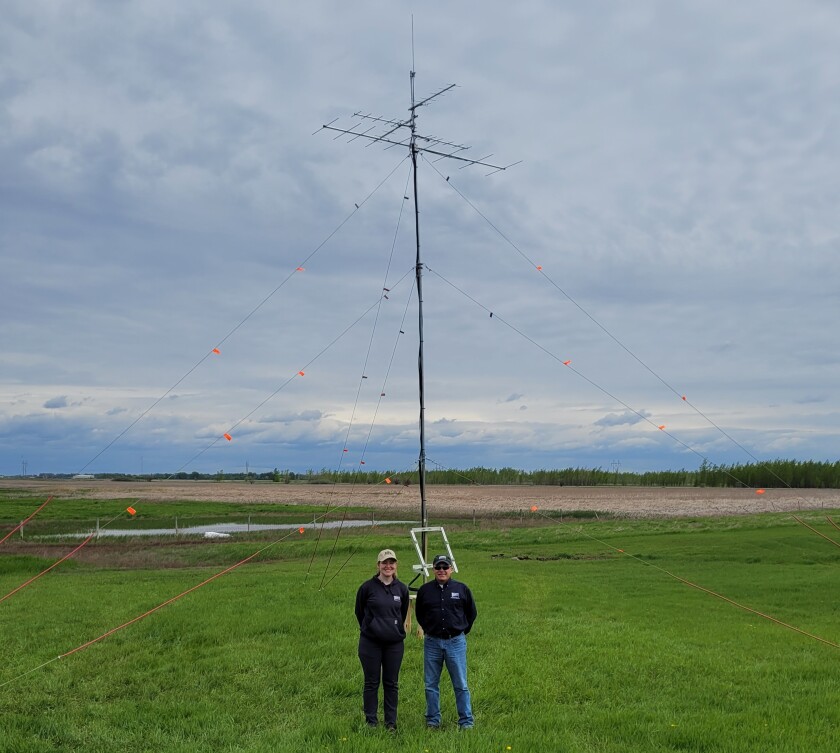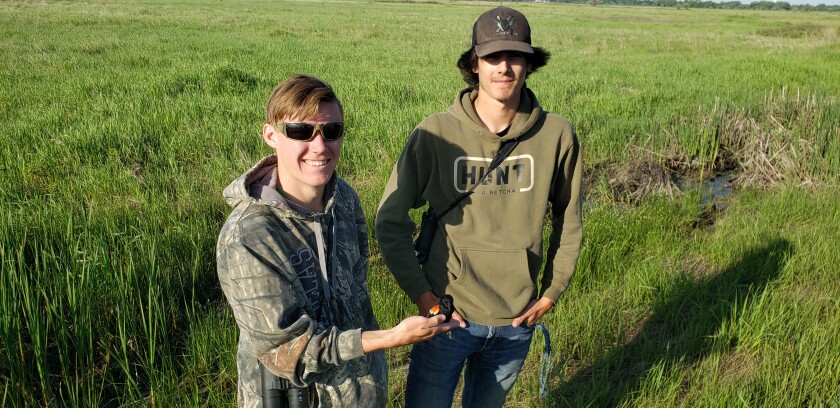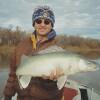GRAND FORKS – The meadowlark was right there, perched on one of the poles supporting the fine-mesh “mist net” Levin Brandt and Jake Knutsen had stretched across the prairie to catch it on this perfect June morning.
From a distance, it almost seemed as if the bird was taunting its would-be captors.
ADVERTISEMENT
Not even a lifelike meadowlark decoy and a recorded meadowlark call played through a Bluetooth speaker could coax the wary bird into cooperating with Brandt and Knutsen.
It goes that way sometimes.

Students in UND’s Fish and Wildlife program, Brandt and Knutsen along with their adviser, Susan Felege, are conducting the fieldwork portion of a multi-partner study that aims to learn more about bird movements and bird-strike risks associated with the Grand Forks International Airport and Grand Forks Air Force Base.
A total of five UND students are involved with the project.
The Grand Forks International Airport is among the busiest airports in the country because of the UND flight school. At the same time, some of the best wildlife habitat in northeast North Dakota is near or between the airport and Grand Forks Air Force Base, said Felege, a professor of Wildlife Ecology and Management at UND.
That includes federal lands such as Pender and Mekinock waterfowl production areas, Kellys Slough National Wildlife Refuge, the Game and Fish Department’s Prairie Chicken State Game Management Area and the city-owned wastewater treatment lagoon, a haven for gulls and waterfowl. There’s also Turtle River State Park a few miles farther to the west.
“You’ve got all this conservation land” near the airport and the base, Felege said. “The Air Force and the airport can only do so much to manage against wildlife to avoid bird collisions with aircraft. And right next to them, you’ve got everybody trying to promote it.”
ADVERTISEMENT
About the fieldwork
Part of this summer’s fieldwork includes trying to catch 25 red-winged blackbirds and 25 meadowlarks to fit them with “nanotags,” tiny telemetry trackers weighing less than half a gram each. The tags, in turn, communicate with a series of seven 30-foot towers the project partners have installed at various sites, including Grand Forks Air Force Base, adjacent conservation lands and the wastewater treatment plant. The towers can pick up the tagged birds up to about 10 or 12 miles away, Felege says, while a series of “nodes” – smaller units about the size of a cell phone – placed in a grid pattern closer to the towers provide finer-scale tracking information within about 250 yards.

The sites are part of the Motus Wildlife Tracking System, described on its website as “an international collaborative network of researchers that use automated radio telemetry to simultaneously track hundreds of individuals of numerous species of birds, bats, and insects.”
Being part of the Motus network allows project partners to share data with researchers along migratory routes and perhaps track birds tagged elsewhere that pass through the Grand Forks study area, Felege says.
The Grand Forks County project and the Dakota Zoo in Bismarck are the only Motus sites in North Dakota, while a half-dozen sites near Winnipeg are part of the network.

“As other people’s tags come here, if we can pick them up, we can use their efforts to understand birds, as well, such as how many shorebirds and other species being tagged near Winnipeg are using Kellys Slough,” Felege said. “How cool is that, to know things about birds coming from all over? There’s a lot of data-sharing you can have.”
As of late last week, Brandt and Knutsen had tagged 14 red-winged blackbirds and 12 meadowlarks. Catching red-winged blackbirds to tag is relatively easy, but as the students are finding out, meadowlarks can be trickier.
ADVERTISEMENT
“Red-winged blackbirds and meadowlarks have two different personalities,” said Brandt, a Fish and Wildlife major from New Prague, Minnesota, who just finished his sophomore year at UND. “Meadowlarks are more cautious. Red-winged blackbirds, you can be right next to (the net).”

For the work at Grand Forks Air Force Base, the project is prioritizing meadowlarks, red-winged blackbirds and mallards. Plans also are in the works to put tracking devices on 25 mallards near the base and 50 birds – including gulls, mallards and blue-winged teal – at the wastewater treatment plant when the equipment becomes available, Felege says.
“The idea with that one is that the wastewater treatment plant is doing all kinds of mitigation to push them out of there so they are not a risk to planes at the airport,” she said. “How long does it take before they come back? Are they going to Kellys Slough? Are they coming all the way over to the wastewater treatment site (at Grand Forks Air Force Base)?
“We’re trying to understand those relationships in this really complex landscape.”
Project partners
Grand Forks Air Force Base, through the Department of Defense, and the city of Grand Forks are funding the project and its estimated cost of about $340,000, Felege says. USDA Wildlife Services, the U.S. Fish and Wildlife Service and the North Dakota Game and Fish Department provide in-kind services such as technical assistance or access to lands where the research is being conducted, such as the Pender and Mekinock WPAs.
“We’re happy to provide that refuge land as a place for the research and learning,” said Emily Fernan, wildlife refuge specialist for the U.S. Fish and Wildlife Service in Devils Lake. “We’re mainly there as kind of the background support. We provided the permits so that they can do the research on our land.
“For the main part, we’re part of this as a partner organization.”
ADVERTISEMENT

According to Kristen Rundquist, natural resources manager at Grand Forks Air Force Base, the military’s role in the project has its roots in a plan the base is required by federal law to have for managing natural resources on the property.
In a nutshell, the base must manage its property in a way that’s less attractive to birds and other wildlife than surrounding lands.
A couple of years ago, Rundquist says, Felege reached out with a proposal for a project that would address the bird movement questions outlined in the base’s natural resources plan.
That resulted in a cooperative agreement between Grand Forks Air Force Base and UND, Rundquist says. The project last year was limited to the base but expanded this year to surrounding lands, including Grand Forks International Airport, Kellys Slough and the wastewater treatment plant site.
“This year, it caught more of a landscape context and excitement from USDA and the city to try and understand the same things we’re doing at the Air Force base around the airport,” Felege said. “It’s really kind of blossomed.”

Some of the towers that now dot the landscape west of Grand Forks won’t be online until later this summer.
“Essentially, if we can extend that geographic landscape farther, I think it benefits everybody in the project,” Rundquist said. “Then, you can see bird movements across a greater landscape if you increase your tower coverage.”
ADVERTISEMENT
City and USDA perspective
John Paulson, North Dakota state director of USDA Wildlife Services in Bismarck, said his agency had worked with the city for “a number of years” on developing a wildlife hazard assessment for Grand Forks International Airport.
The assessment provided an in-depth look at wildlife in and around the airport and attractants for wildlife, Paulson says, such as grasses of a certain height and fencing around the facility.

“The bigger thing that we noticed is you’ve got lots of habitat around that airport,” he said. “You've got the Grand Forks wastewater treatment plant, which has lots of open water and lots of attractants for lots of different bird species, you’ve got Kellys Slough, you’ve got a landfill that’s not that far away.”
To mitigate bird-strike risks at the airport, the city of Grand Forks partnered with USDA Wildlife Services about six years ago to have a part-time employee stationed at the wastewater treatment plant to harass birds off the site, Paulson says.

The result was fewer bird strikes at Grand Forks International Airport. So far this year, for example, seven bird strikes have been recorded at the airport as of May 25, according to data from the Federal Aviation Administration.
“We were successful,” Paulson said. “We definitely reduced the strikes that were happening at the airport, and that was our goal.”
Last year, the city made the hazing position at the wastewater treatment plant full-time, Paulson says, hiring Dorothy Daulton, a UND master’s degree student who approached him about doing graduate research on the site.
ADVERTISEMENT
That resulted in a conversation with Felege to expand the tracking and bird-strike project to include the airport and wastewater treatment lagoons. The research not only provides learning opportunities for UND students, it’s also practical, said Melanie Parvey, water works director for the city of Grand Forks.
“We work with the university on a couple of other projects in the areas of water and wastewater, so it just seemed like a natural fit,” Parvey said. “Our goal is to treat the wastewater to meet our discharge permits. We aren’t so good with birds and mitigating those, and so when somebody’s got that expertise, it just made sense for us to pay them for that, and then we were able to work together and bring in some interns, too.”
What the expanded research ultimately reveals about bird movements and strike risks remains to be seen, but with the tower infrastructure in place, Felege says she hopes the project can continue into the future with tagging even more birds that use the lands.
“I think it has potential to extend long term, but that will depend largely on partners and their desire for maybe funding additional tags to keep active work going,” she said. “I expect it to be a few years anyhow, but how long beyond that, I don’t know.
“It will probably depend upon how valuable the data is.”















